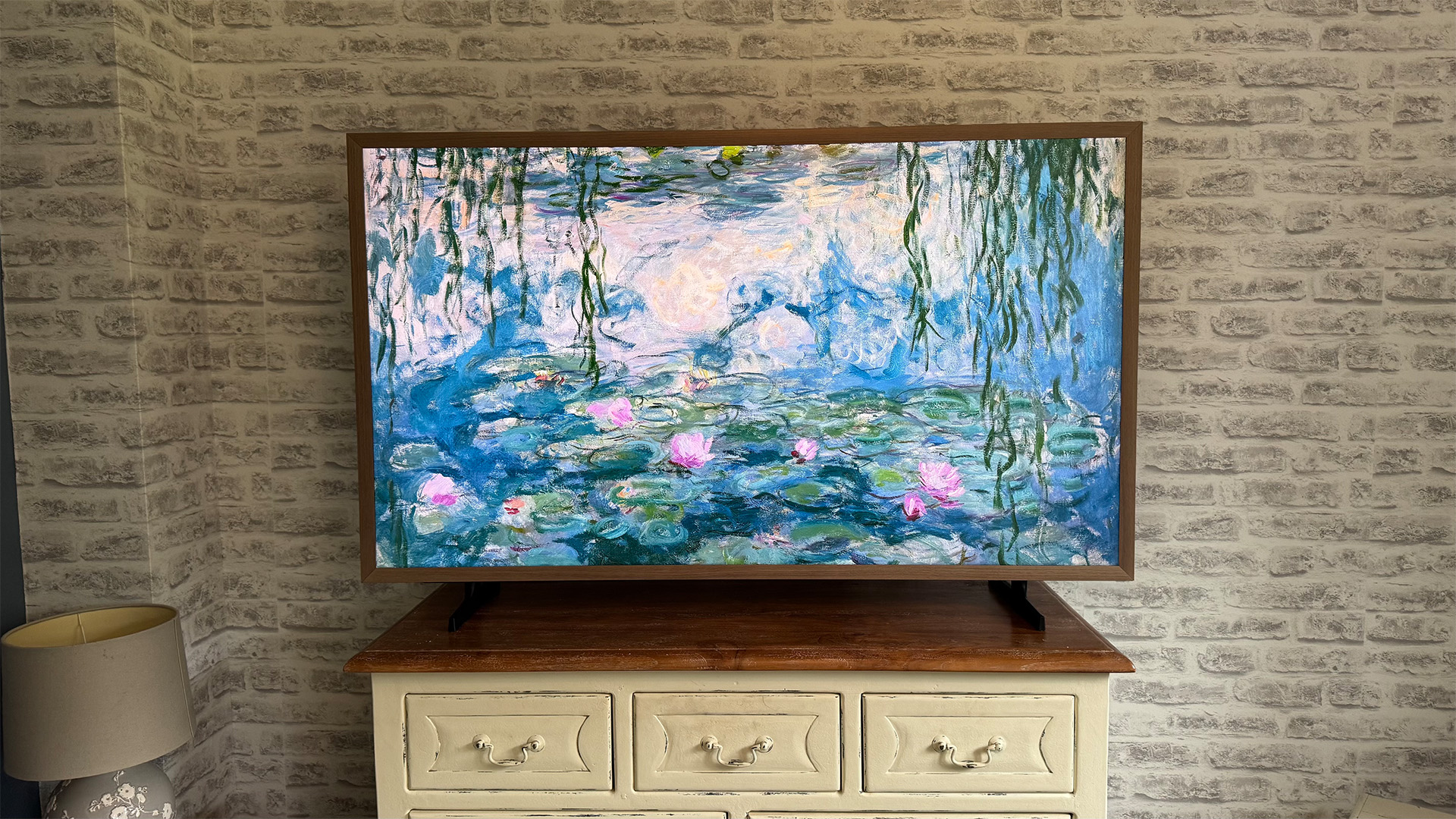TOP AUDIO VIDEO MILAN 2011: 'It's a pity you didn't come last year...'
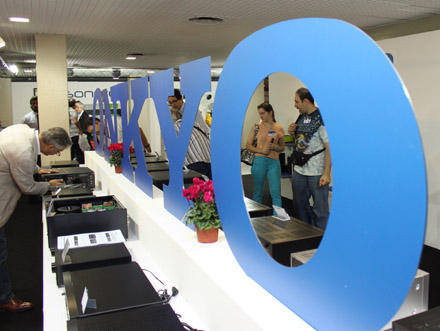
I'm often told hi-fi shows aren't what they used to be, and those with fond memories of thronged corridors and packed rooms often express a wistful desire to go back to those days.
You can see their point: with the possible exception of the Bristol and Manchester Sound and Vision shows, there's a distinct lack of 'buzz' about shows these days, even though in recent years just about every format has been tried, from hotels to exhibition centres and back again.
Europe now has only one really major international show, the 'does what it says on the tin' High End Show in Munich, while in the States there seems to be a growing trend toward many regional shows, rather than one or two big national events for consumers.
Maybe people don't want to travel these days; maybe it's just a reflection of the perilous state of so many economies around the world, maybe it's even that the internet lets us see and experience so many products in a virtual manner – whatever the reason, it seems big hi-fi shows are falling out of favour.
However, there's always been one that's spoken of in hushed tones by those in the know: the Milan show – the Top Audio Video Show to give it its full name – is always held up as a paragon of how hi-fi can be made stylish, attractive, sexy even.
This year, after hearing about this legendary show for so long, I was lucky enough to be invited to attend and cover some product launches, thus giving me a couple of days to soak up some of the glamour.
You'll have seen the coverage of the two big British launches late last week in our news section: Naim rolled out its ND5 XS streaming player first thing on Thursday morning, just as the show opened, while Neat Acoustics waited until later in the day to unveil its huge, and really rather desirable, Ultimatum XL10 speakers.
Get the What Hi-Fi? Newsletter
The latest hi-fi, home cinema and tech news, reviews, buying advice and deals, direct to your inbox.
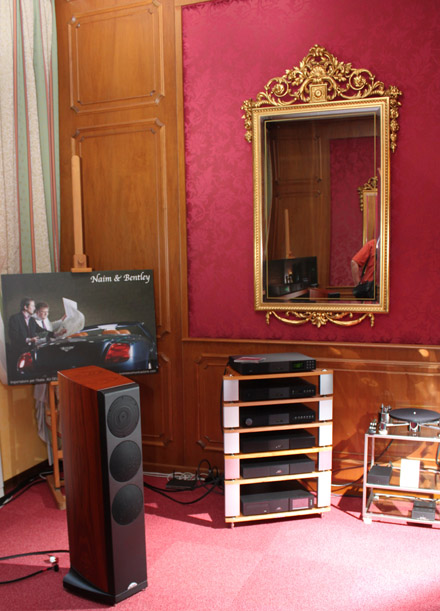
The Naim sounded good in a wood-panelled hotel room (above), connected to the company's slimline XS-series preamp and power amp, and driving the Ovator S400 speakers, even if our listening was somewhat distracted by the arrival of the maintenance guys to fix the recalcitrant air-conditioning system.
We needed the AC: temperatures in Milan were hitting 30C or so, and apparently the sun was shining – not that I saw it, thanks to the fact I was staying in the show hotel, and that hotel was on what looked like the Milan ring-road, in a fairly bleak wasteland of seemingly abandoned office blocks.
We also had a presentation from Focal's Gérard Chretien (left) and Naim's Paul Stephenson, who discussed the recent merger of the two companies under the Focal & Co umbrella.
Stephenson explained that the merger was really the only way for Naim to progress into new technology areas such as its fast-growing streamed-music range, given the huge cost of developing software – 'You want it to do that? That'll be another million' –, the licenses involved in this technology and so on.
Chretien, meanwhile, spoke of the way the companies will pool resources in research and development, which goes way beyond the over-simplistic (and erroneous) suggestions some have made about Focal making Naim speakers, or Naim electronics being built into active Focals.
The two companies are thinking platforms, not products – what they produce will remain unique to each company, but resources will be pooled on the design of basic technology with which they can each work.
Show 'n' tell
Despite the deal only being announced a few weeks back, some Naim engineers have already been down to Focal in St Etienne for what was described as 'a technology show 'n' tell', and Stephenson emphasised that, with the new financing available from the merger, Naim is actively recruiting new engineering staff.
Focal, for its part, had an enormous room set aside to demonstrate its Utopia series, both in two-channel form, with a pair of the big Stella Utopia EM speakers driven by electronics from Canadian company Moon – no, not Naim – and a complete surround system showcasing a new subwoofer, the Utopia EM, making its debut at the show.
This is a big sub by any standards, and with a €10,000 price-tag to match the Utopia range, which runs from €9000 a pair for the Diablos to €130k for the flagship Grande Utopia EM. Helpfully, Chretien adds that the sub is stackable, so you could use three or four of them if you wanted!
Utopia may seem like no more than a statement product for Focal, which after all makes most of its money from more prosaic products, car speakers and the like, and is soon to launch its Bird 'lifestyle' speakers across Europe, combining little speakers just 14cm tall with an interesting Power Bird combined amplifier and subwoofer.
Utopia to go active
But as Chretien explains, the Utopia range accounts for 20% of Focal's sales, and the company is committed to developing the range. An active system is on the way, with a digital crossover box replacing the conventional passive crossovers in the current speakers.
That way consumers will be able to choose their own amplifiers to use with the speakers: the company has no plans to build amps into the speakers themselves.
'So,' Chretien added, 'you can use the speakers with a separate crossover box, and as many amplifiers as you need.'
No-one mention the Naim six-pack, or we'll be here all night...
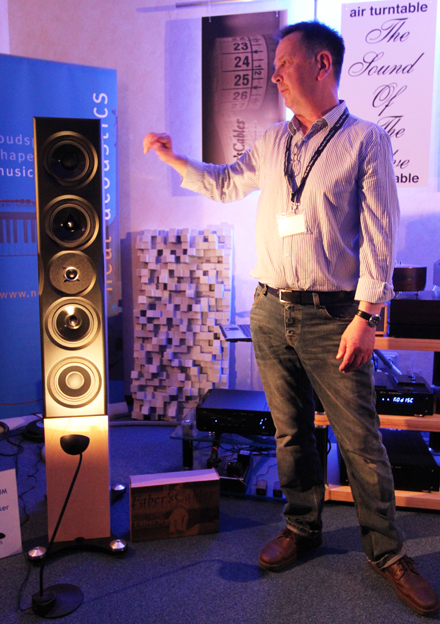
Talking of big speakers, how were the Neats? Well, it was late in the day when we got to hear them, and the room down in the basement where they were being demonstrated by Neat's Bob Surgeoner (above) was nicely snug and cosy after a day of amplifiers running all day.
However, the new speakers showed definite, and considerable, promise, even if the turntable and electronics driving them, chosen by the Neat Italian distributor, seemed to be doing them few favours.
Complete with air-tanks and pumps and all kind of flotation devices, the turntable seemed the major culprit: when we switched to some music run from computer things were rather more impressive.
And those computers, plus assorted associated paraphernalia, were everywhere. I saw at least three or four more devices built on the now increasingly familiar StreamUnlimited platform, as used in the Musical Fidelity M1CLiC player I've recently finished reviewing for our sister magazine Gramophone.
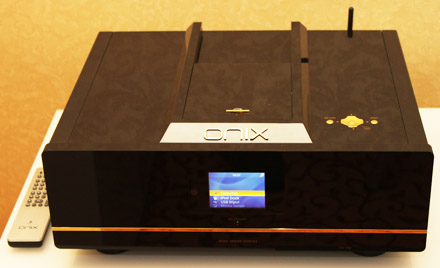
British company Onix was showing a combined CD player/server/streamer system, the DCD10S, alongside a new integrated amplifier and phono stage, while in those rooms without dedicated streaming players, laptops – or more often netbooks – fed everything from pocket-sized DACs to substantial devices such as the Vaughan 384kHz/32-bit capable model (below) from Italian digital company M2Tech.
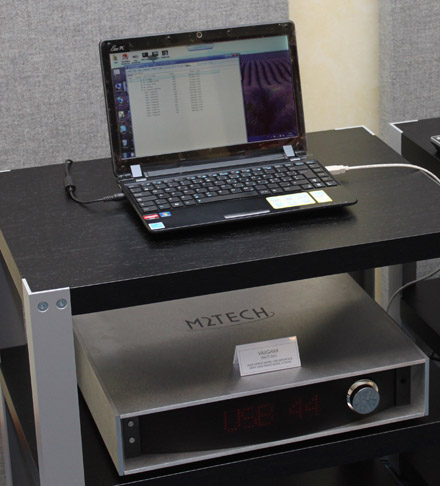
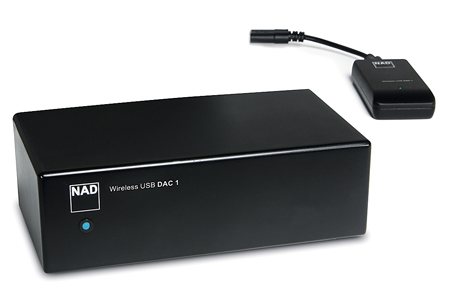
A couple of surprises awaited me in the NAD room: the company's small, and anonymous to the point of near-invisibility, DAC 1 converter (above) was on show, complete with its USB transmitter to send music to it from a computer.
Somewhat more obvious was NAD's own iPod/iPhone speaker dock system, complete with very familiar-looking styling, even if the bulked-up design (below) is perhaps more Goodyear blimp than Zeppelin.
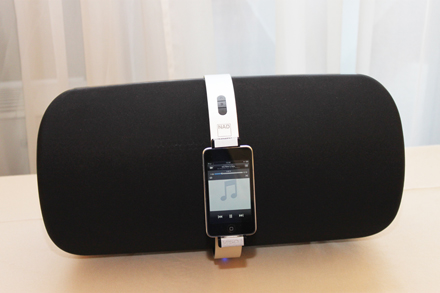
Walking around the main display areas of the show, located off the hotel's foyer and down on the first basement floor, I was impressed by the quality of the stands, and the thought that had clearly gone into them. Denon had a simple white cube full of its products, Pro-Ject had arranged its turntables to catch the eye, and the B&W stand looked classy.
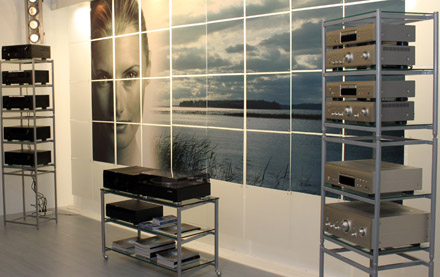
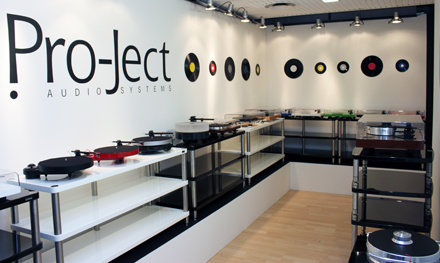
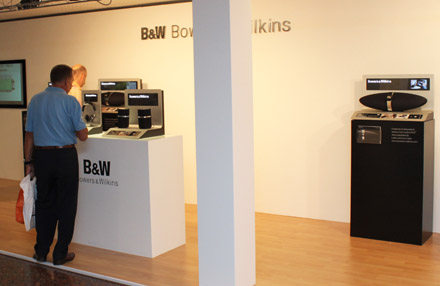
Onkyo grabbed the attention with its super-sized logo above a simple line-up of its products, while US brand McIntosh chose to mount its extensive range of electronics into what was swiftly dubbed the McWall.
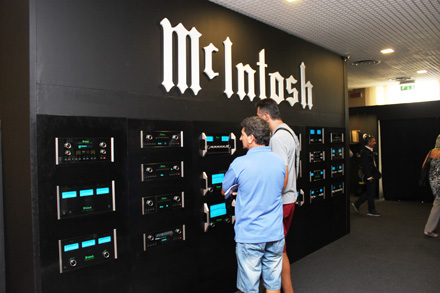
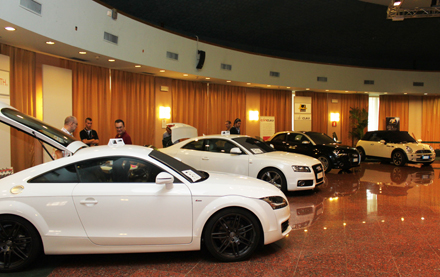
In a rotunda to one side of the main lobby some principal Italian passions – music, cars and coffee – were combined with the in-car demonstrators fanned out from a central coffee bar, even though the metal on show was more German than Italian.
Meanwhile in the amusingly-named Aquarium hall companies from Asus to Yamaha had stands showing their products off in a manner that seemingly eludes British show designers.
Buoyed by these classy displays, I wandered into the hotel corridors, where the rooms promised to hold all that glamour of fine music played on superb systems.
And was brought up abruptly by the kind of things I remember being all wrong about those hi-fi shows now made legendary by nostalgia.
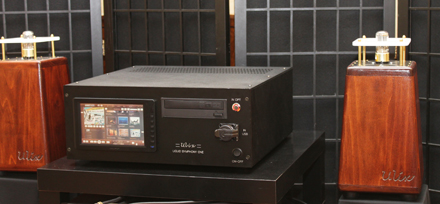
You see, away from the show-floors, over-hot, dark rooms along the corridors were crammed with unfathomable equipment, set up in ways that were more confused than con brio – the set-up above, from Italian brand Ulix, was one of the smarter ones.
Systems were being listened to by small knots of people, many of whom seemed to be close friends of the exhibitors, judging from the animated conversations going on all the time music was playing.
And what music! I'd despaired a little at the undemanding, breathy-saxed plinky-plonkiness Focal had used for its demonstration, but it was explained to me that this was what Italian enthusiasts like.
Clearly they also like Pink Floyd, The Eagles and – saints preserve us – Dire Straits, as I think I heard most of Dark Side and more than all of Brothers in Arms as I went from room to room, interspersed with that quiet, laser-etched, ultra-technical jazz you only ever hear at hi-fi shows.
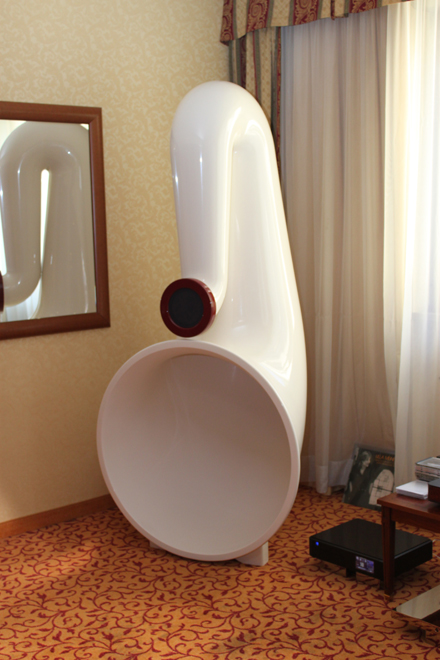
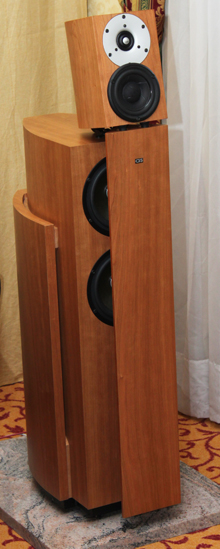
Yes, there were products to amuse, such as these huge horn loudspeakers (above) – the Arcadian Audio Pnoe, at prices starting from €24,000, crowded into a relatively tiny space.
Pnoe, for the non-classicists, means 'breath of life' in Greek. Oh, and 'wind'.
Also interesting – well, alright then, different – was Audiosonica's €11,400/pr Dragonfly (left), with its 'small speaker on top of a big speaker' design.
It's not a new speaker, but it was new to me, and I gather the baffle over the bass drivers is there to give a more diffuse sound.
Tough times
Speaking to some of the other Brits at the show, there was a firm opinion that the tough economic climate is causing those who might previously have spent some money dressing their room – to make it attractive to visitors (not to mention treating it to sound good) – not to bother.
Meanwhile other ultra-tweaky 'garage' companies may have picked up rooms at bargain prices, filled them with some friends, and done a sort of glorified 'play what you brung' exercise.
Information – even in Italian – was hard to come by, and the generally haphazard plonking down of equipment, with cables everywhere, was hardly inspiring.
Pronto?
Oh, and there's a new twist these days: it seems Italian phones no longer provide a silent mode, but instead have ring-tones from the sound of cicadas and other wildlife to strident music, permanently set to maximum.
They go off, are answered, and get shouted into for several minutes, even during the course of a demonstration. And that's just by the people supposedly presenting their product to the public; the visitors are much worse when it comes to their mobile (lack of) etiquette.
In one room I heard a demonstration carried out with someone even larger than I standing in front of one speaker; in another, the sandwiches arrived, were discussed and then paid for centre-stage mid-dem. And of course there are the air-conditioning engineers who wandered into the Naim room...
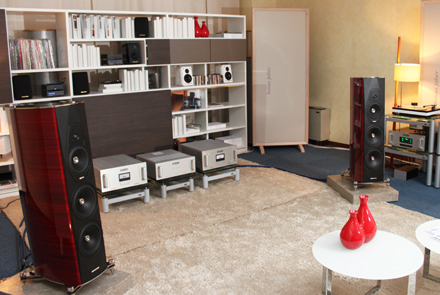
While the smart 'room set' built by Sonus Faber in an anonymous hotel space (above) was very impressive, I was underwhelmed, for example, by the room of the distributor of one of Britain's best-known speaker brands, which had a definite air of the jumble-sale about it.
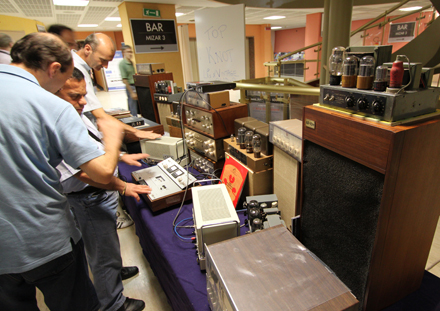
No wonder, perhaps, that I saw more animation from visitors when looking at the pile of dusty 'pre-loved' equipment on a trestle table in one of the lobbies (above), complete with a hand-written sign on a flip-chart, the odd Quad or old Marantz amp in plastic bags, and a Sony pro cassette deck – seemingly ex-BBC at some point – on for €200.
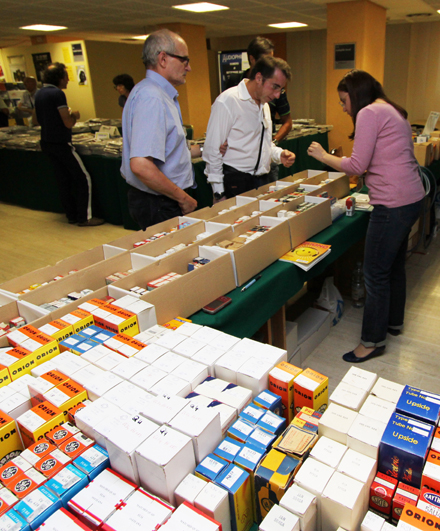
There were excited discussions over a stall selling every valve you could ever imagine,
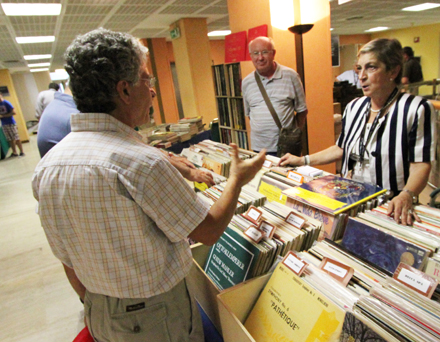
and at the many places with secondhand LPs on sale, with everything from vintage rock and pop to that vital breathy jazz and even a huge choice of classical music at sensible prices to tempt one beyond carry-on baggage limits.
But the legendary Milan show glamour seemed in very short supply this year, and several times I was told 'You should have been here last year...' – though I'm informed that this year the coffee not only tasted better, but was also delivered rather more efficiently, than at previous shows!
For years I have heard that, since the decline of the big hotel-based UK high-end events, the Milan show demonstrates just how the industry should be selling hi-fi to the public these days.
Having experienced this year's show, I'd suggest we should be a bit more careful what we wish for...
Andrew has written about audio and video products for the past 20+ years, and been a consumer journalist for more than 30 years, starting his career on camera magazines. Andrew has contributed to titles including What Hi-Fi?, Gramophone, Jazzwise and Hi-Fi Critic, Hi-Fi News & Record Review and Hi-Fi Choice. I’ve also written for a number of non-specialist and overseas magazines.
